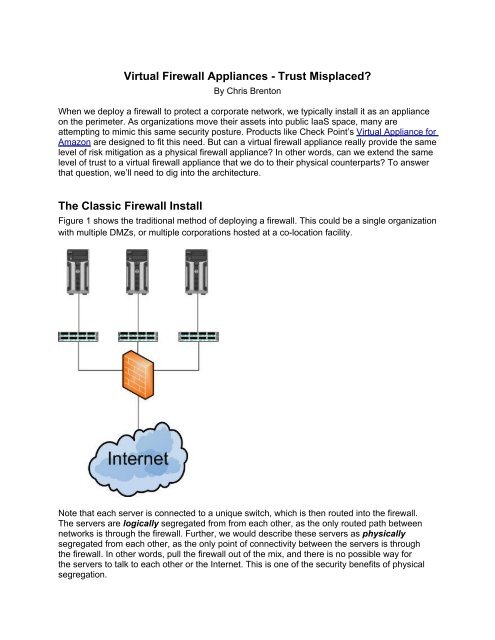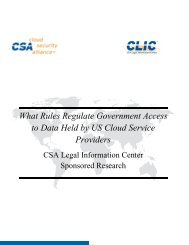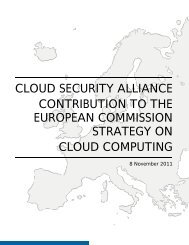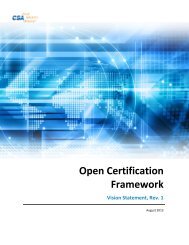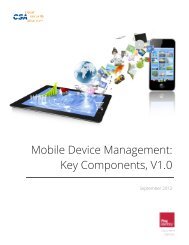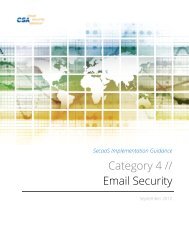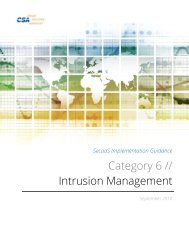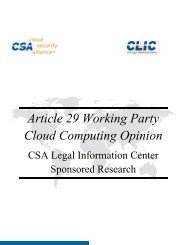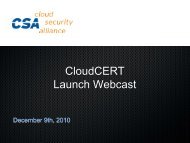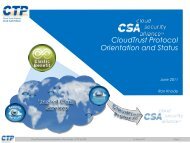Download (pdf) - Cloud Security Alliance
Download (pdf) - Cloud Security Alliance
Download (pdf) - Cloud Security Alliance
You also want an ePaper? Increase the reach of your titles
YUMPU automatically turns print PDFs into web optimized ePapers that Google loves.
Virtual Firewall Appliances - Trust Misplaced?By Chris BrentonWhen we deploy a firewall to protect a corporate network, we typically install it as an applianceon the perimeter. As organizations move their assets into public IaaS space, many areattempting to mimic this same security posture. Products like Check Point’s Virtual Appliance forAmazon are designed to fit this need. But can a virtual firewall appliance really provide the samelevel of risk mitigation as a physical firewall appliance? In other words, can we extend the samelevel of trust to a virtual firewall appliance that we do to their physical counterparts? To answerthat question, we’ll need to dig into the architecture.The Classic Firewall InstallFigure 1 shows the traditional method of deploying a firewall. This could be a single organizationwith multiple DMZs, or multiple corporations hosted at a co-location facility.Note that each server is connected to a unique switch, which is then routed into the firewall.The servers are logically segregated from from each other, as the only routed path betweennetworks is through the firewall. Further, we would describe these servers as physicallysegregated from each other, as the only point of connectivity between the servers is throughthe firewall. In other words, pull the firewall out of the mix, and there is no possible way forthe servers to talk to each other or the Internet. This is one of the security benefits of physicalsegregation.
Mitigating The Risks of a Virtual SwitchFortunately, we have some options available to us if we need a higher level of risk mitigationthan what is provided by a virtual firewall appliance. The first is to leverage a hypervisorbased firewall. VMware’s vShield is probably one of the best known products in this vertical. Ahypervisor based firewall moves the firewall to the other side of the virtual switch, thus mitigatingany risks within the switch itself. A logical example is shown in Figure 3.The problem with hypervisor based firewalls is that they are vendor specific. For examplevShield only runs on VMware’s own hypervisor, and is not supported by KVM, Zen or any otherhypervisor solution. Further, your public provider may not support hypervisor based firewalls,so this may not even be an option. Even if they do, hypervisor based firewalls require the useof introspection which brings with it its own additional risks in a public cloud environment. Soultimately you may simply be trading one set of risks for another.Your other option is to simply leverage the firewall software built into most modern dayoperating systems. Host based firewalls control traffic as they pass in and out of the virtualmachine, so they are more than capable of negating any potential risks within the virtual switch.This option is also the least expensive, as the firewall is already present within the operatingsystem. Finally, this option is also the most portable. If you move the VM to another cloud, the
protection afforded by the host based firewall obviously moves with it. This is not true for any ofthe other firewall solutions discussed earlier in this post.Wow, how often do we see the cheapest solution being the most flexible and providing thehighest level of risk mitigation? ;-)


